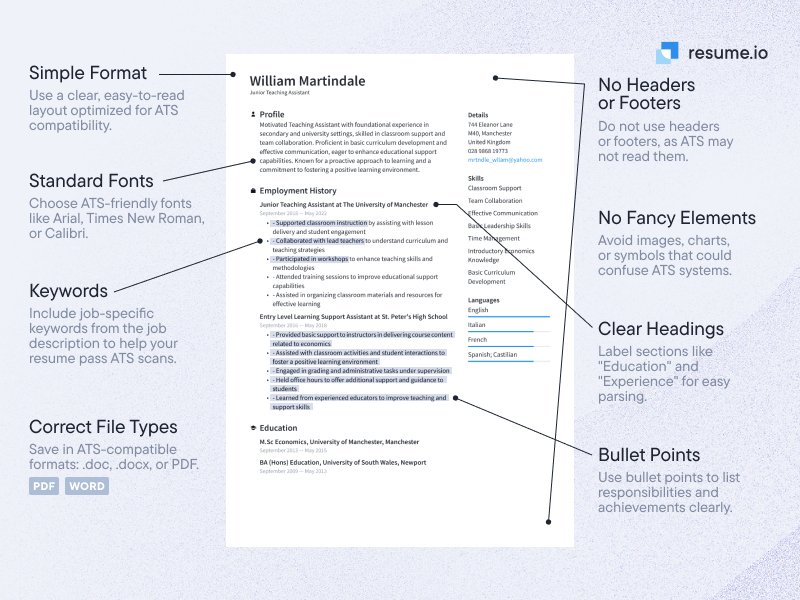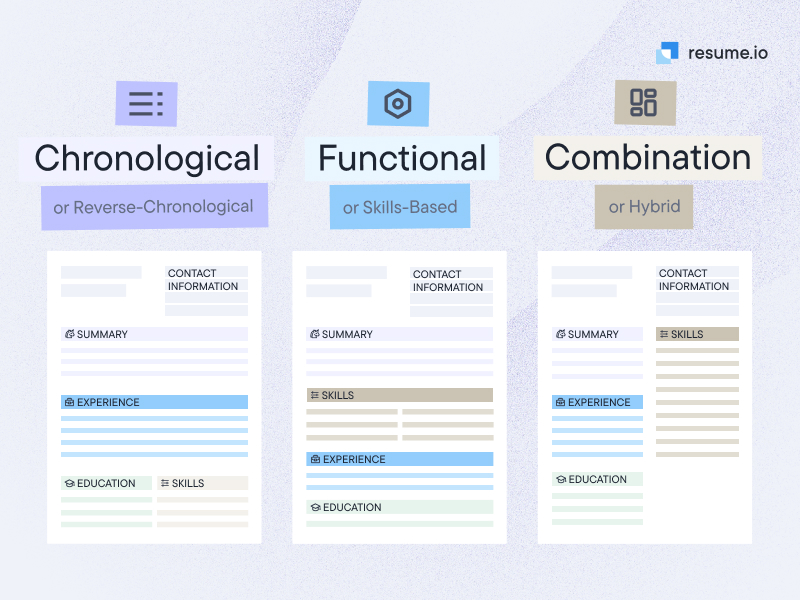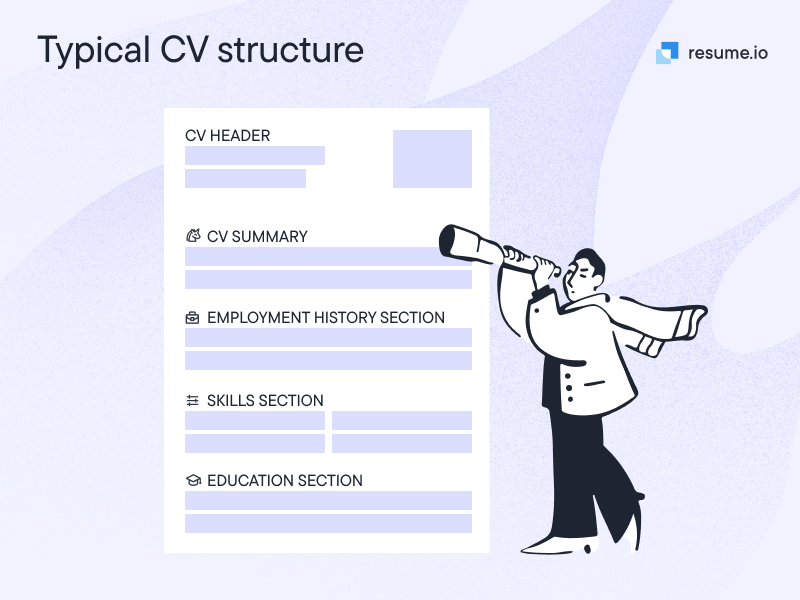Hiring managers often receive hundreds of applications for a single job posting. In order to help reduce the workload, it is becoming commonplace for companies to have an ATS (Applicant Tracking System) in place that allows them to screen CVs quickly and efficiently.
If you've ever wondered why you haven't heard back from a company even though you have the same experience they are looking for, then the chances are that an ATS filtered out your CV. In short, this means the employer has never actually looked at the CV.
Ultimately, you could invest a lot of time writing your CV, but it could be a wasted effort without it being ATS-friendly. Therefore, you should not overlook the importance of an ATS-friendly CV.
In this blog, we will look at:
- What an ATS is and why companies use it
- What an ATS CV is and why it is a necessity
- How to create an ATS-friendly CV
- Information on why companies use an ATS
- Tips on how to follow up on your job application
99% of Fortune 500 companies are using an ATS. This stat gives you a good insight into the importance of an ATS-optimised CV.
What is an ATS?
An ATS (Applicant Tracking System) is a CV-scanning algorithm used to filter out candidates who do not meet the requirements for the role, usually based on the job description. Most ATS scanners are built right into common online application portals and implemented by companies to make the recruitment process more manageable. For some organisations, it is impossible to deal with the vast amount of CVs they receive.
Recruitment agencies and popular organisations with a strong reputation are most susceptible to receiving large amounts of applications. Companies like Amazon, which received 30,000 UK applicants in one day, find an ATS particularly beneficial for screening applications as quickly as possible.
Why do companies use an ATS?
If you understand exactly why a company may use an ATS, it puts you, as a job seeker, in a better place to comprehend the importance of ensuring your CV is ATS friendly. Not only when you apply for a job but also for the future. These are some reasons companies use an ATS.
- Efficiency – as mentioned above, an ATS makes the recruitment process much quicker. The ATS will instantly remove those applications that are not relevant. It is excellent for the company, but what about the candidates? This is why you need to do all you can to ensure it passes through the ATS with ease.
- Future Needs – companies also use an ATS to store information about applicants. It helps them create a talent pool and use the CVs for future needs. If you bypass an ATS but don't get selected, you still have a chance of being considered in the future.
- Improve quality – employers need to make the right hiring decisions. Anything else can be costly. An ATS allows them to improve their screening processes and hire better quality candidates. Another reason it is so crucial that your CV is ATS friendly.
- Build relationships – when you get through an ATS, it gives you the chance to be selected for future roles and opens up the possibility to widen your network. Employers tend to use an ATS to build relationships with candidates, so there is no looking back once you get through that door!
What is an ATS-friendly CV?
When you apply for a job online, you should always assume that there is an ATS in place. Your CV needs to be in an uncomplicated format to get the nod from an ATS, and it should contain associated keywords from the job description. If a human were reading the CV, they would be able to understand if you are suitable for the job quickly. However, an ATS isn't able to do this, so you need to make it as simple as possible for them. For instance, if the role required specific system experience, you would ensure this was somewhere on your CV. You can pick out keywords from the job spec you know the employer will need and place these onto your CV.
How do I make my CV ATS compliant?

The addition of keywords is an integral part of the story when making your CV ATS friendly, but they are only one part of the story. There are other ways you can give your CV the best possible chance of escaping the clutches of the ATS and ensuring you land on the hiring manager's desk! Here are some tips for creating an ATS-friendly CV:
Use a standard CV format
As the chronological format is the most popular CV format, it is also the format that works best with an ATS. With this, your experience is the most prominent feature of your CV. Ultimately, this is the most relevant for employers. If you have significant employment gaps or your work history is extremely choppy, you might want to reconsider this approach. However, a chronological format is the best way to format your CV for most job seekers.

Simple design
Job seekers tend to overthink the design of their CV, as understandably, they want to find creative ways to stand out from the other candidates. However, it is always best to keep the design simple for various reasons. It will look more appealing to the hiring manager, but it is also more likely to pass through the ATS. If a CV is difficult to read, such as those that contain tables, images, etc., the ATS may find it difficult to read and might just reject it. ATS systems like simplicity; otherwise, they struggle to comprehend the information. A perfectly good CV could be discredited within minutes because it is a complicated design. Don't let yours end up in the ATS trash!
Standard headings
The best approach when formatting your CV is to keep it simple and use recognisable words for your headings. It might seem like these make your CV 'boring' or just the same as all the others, but this is the best way to help ensure you get through the ATS. This is a good format to stick to when writing your CV:
- Header
- Summary
- Experience
- Skills
- Education

Popular font
You should also stick to one of the standard, popular fonts, such as Times New Roman, Calibri, or Arial. It is easier for the ATS to read if it's in a recognisable font.
Recognisable file type
You should save your CV as a recognisable format such as .docx or PDF unless the job spec says otherwise. These are standard formats, which are more recognisable to the system. Make sure you read the job spec thoroughly as if you don’t send it in the right format, it might become scrambled in the employer’s system or even immediately rejected.
Related keywords
The most important way to create an ATS CV is to ensure it has related keywords. These are the keywords listed on the job spec.
Take a look at this sample job description:
We are currently looking for an administrative assistant with financial services experience. In addition, you must have excellent customer service skills and the ability to manage client relationships. Proficiency in Microsoft Office products and an ability to manage your time effectively is also crucial in this role.
In this case, some of the keywords you want to ensure you have on your CV include customer service, Microsoft Office, financial services, administrative assistant, and client relationships. You shouldn't aim to copy the job spec, but lift out the main keywords and place them in an appropriate part of your CV to be more likely to pass through the ATS.
Why are CVs rejected?
CVs are rejected for many reasons, even if they pass through the ATS. It may be the case that the hiring manager has been inundated with suitable candidates and only wants to spend a short period of time interviewing. In this case, they may only select three or four candidates. Another reason is that they may feel that you are overqualified for the role. The beauty of passing through an ATS, is that your details will stay on the system for future roles.
How do I know if my CV is ATS-friendly?
If you follow the above advice, your CV will be ATS friendly. However, if you are applying for a lot of relevant roles and not getting any response at all, we would always suggest that you are proactive and follow up on your application. Most employers will appreciate candidates taking the initiative, and it will only be viewed as a positive if you follow up.
- Ensure your CV is standardised; there is no need for gimmicks
- Send a clear, concise CV that is easy to read
- Read the job spec and ensure you send it in the proper format (if mentioned)
- Spell check your CV before submission
- Scatter relevant keywords throughout your CV
- Create an overly complicated page design
- Include cute or creative subheadings which may confuse the ATS
- Add the job description in white text or use other “ATS tricks” that rarely work
- Stuff your CV with repetitive keywords
- Lie about your experience just to please the ATS
How to follow up on your job application
This blog's advice will help you ensure your CV passes through an ATS and, therefore, reach the hiring manager with ease. However, if it goes silent at the other end, and it is a week after the closing date, we would suggest following up. These are some tips for following up on your job application.
Send an email
If you know the name of the hiring manager or the recruiter, there is no harm in sending a follow-up email. Of course, there is no guarantee that they will delve further into it if it has not ventured through the ATS, but following up is always advisable.
Dear Mr. Brown,
I applied for the marketing manager position on 26th March 2022, and I have not heard back since the closing date.
I am excited by the role and your esteemed company, and I feel that I have all the skills and qualities necessary for the position.
I appreciate that you are extremely busy, and if there is any further clarity you need about my application, feel free to get in touch.
Kind regards,
Lucy Wilson
Make a call
If you prefer to speak to someone directly, it would be best to call the general recruitment team (if there is one) rather than the hiring manager. You may take them by surprise, and you might catch them at an inconvenient time. Phone calls can go either way. Some people prefer this form of contact, while others prefer email. If nothing else, it will allow you to get an answer more quickly than waiting for an email response.
Hello, my name is Lucy Wilson, and I submitted an application for your marketing manager role on 26th March 2022, and I haven't received a response yet. So I just wanted to check that you had received it and what the timeline for the hiring process might be.
It is essential to understand that even if you have the exact experience and skills for the role, it doesn't necessarily mean that you will be invited for an interview. Of course, you can do your best to make your CV ATS friendly, but you can't predict what the hiring manager has in mind. So if you don't get selected, don't be despondent. There are always other opportunities out there!
Key takeaways
- If you ensure you have an ATS friendly CV, it won't just help with your current application; it may also give you a better chance to be considered for future opportunities.
- Use a standard approach when writing your CV and ensure relevant keywords are used from the job spec.
- Keep the design simple and don't overcomplicate it. Simplify it for the ATS system.
- Don't be afraid to follow up on your application if you haven't heard back and you feel that you have the right skills.
- View our CV examples and our job-winning ATS CV templates for additional inspiration, so you can build your ATS-friendly CV!








